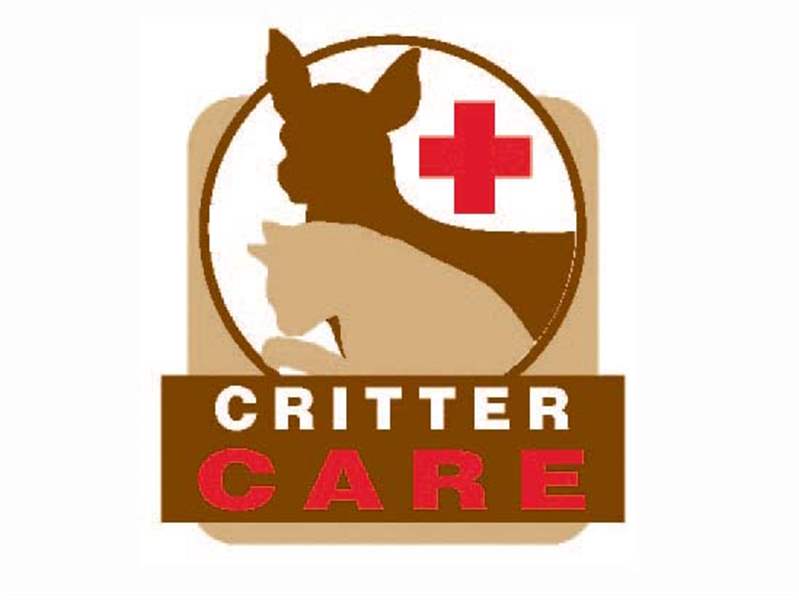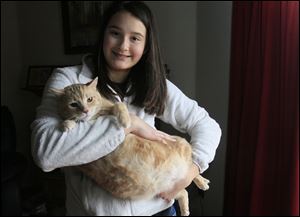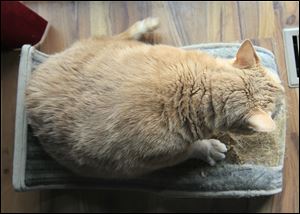
CRITTER CARE
Obesity has become a big medical concern for pets
Tabby Elmer once tipped scales at about 23 pounds
4/15/2013

Emily English of Maumee holds her cat Elmer. The cat was skinny when she first rescued him, but ate and ate to make up for all the meals he missed. He now tops the scale at 19.5 pounds — and that's actually down from about 23 pounds.
Emily English’s cat Elmer doesn’t miss any meals, as evidenced by his girth.
You can’t really blame the 6-year-old orange tabby cat. When the English family found him under a neighbor’s tree in February, 2009, he was very thin.
“We took him in and he ate and ate,” said Ms. English of Maumee. “We believe he got to the size he is today because he is afraid to go without food again.”
The 19.5 pound cat was put on reduced-calorie food about six months ago and has lost about 4 pounds.
Ms. English, 14, is a freshman at Maumee High School. She, her parents, William and Kimberly, and siblings, Ethan, Elise, and Erick, all try to get Elmer to play more to take off the weight, but he’s just not that interested.
“We try. He loves laser pointers but just sits there and smacks it,” she said. “The only other thing he plays with is string. Bambino, our boxer mix, chases him and lays on the ground and plays with him.”
The English family fosters animals before they go up for adoption through the Toledo Area Humane Society and Planned Pethood, and Elmer enjoys checking out the newcomers.
“He likes all the baby kittens we foster and the puppies just jump all over him, but he doesn’t mind,” Ms. English says. “He is the most patient cat.”
She worries about how the weight will affect his health.

Emily English says she and her family try to get their cat Elmer to play and exercise, but he isn't interested. Emily says he likes laser pointers but will just swat at them.
“When we go to the vet for yearly appointments, they check his heart and his lungs extra carefully,” she said. “When we notice he isn’t acting right, we get him in to the vet right away. As he gets older, we worry about him more. So we are hoping the [reduced-calorie] food starts working so he will be at a less obese weight.”
With pets sharing our increasingly sedentary lifestyles, obesity has become a major medical concern for dogs and cats, said Dr. Gary Thompson of West Suburban Veterinary Hospital.
“The added pounds are a burden on joints, and the resulting strain can lead to back problems, ligament tears, and arthritis,” he said. “Overweight cats can develop diabetes and are prone to a serious form of liver failure called hepatic lipidosis.”
He suggests long walks for dogs who are trying to lose weight.
“Cats are more difficult to engage, but find a toy they like and make interactive play a part of your daily routine,” he said. “Restricting calories will only have limited success and increasing the calories they burn will take the weight loss to another level. The higher fitness level increases lean-muscle mass, strengthens joints and ligaments, and raises the metabolic rate so the weight is easier to keep off.”

Insulin-dependent diabetes and heart failure are the major health risks associated with obesity in dogs, he said.
“There is a difference between simple and easy,” Dr. Thompson said. “Losing weight is simple — consume fewer calories than you burn. However, as we all know, that is far from easy. Another factor working against you is that pet food bags have wide-ranging feeding guidelines. Different brands have dramatic variations in the amount of calories in one cup of food, as well.”
Measuring a pet’s food at each meal is important both for those trying to lose weight and those trying to maintain a normal weight.
For dogs, owners can switch to a low-calorie treat, such as baby carrots or biscuits broken into smaller pieces, he said.
“Sometimes this alone is all that is needed,” Dr. Thompson said. “Seventy-five or 80 calories in a dog treat adds up quickly over time. You can help your dog stay satisfied with a few smaller meals through the day as well. This means less fat deposition associated with one or two larger meals.”
Contact Tanya Irwin at: tirwin@theblade.com or 419-724-6066.